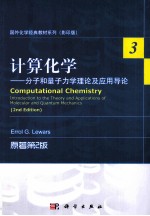图书介绍
计算化学 分子和量子力学理论及应用导论 英文pdf电子书版本下载

- (加)里沃斯(E.G.Lewars)编著 著
- 出版社: 北京:科学出版社
- ISBN:9787030332998
- 出版时间:2012
- 标注页数:664页
- 文件大小:30MB
- 文件页数:678页
- 主题词:化学-计算机应用-高等学校-教材-英文
PDF下载
下载说明
计算化学 分子和量子力学理论及应用导论 英文PDF格式电子书版下载
下载的文件为RAR压缩包。需要使用解压软件进行解压得到PDF格式图书。建议使用BT下载工具Free Download Manager进行下载,简称FDM(免费,没有广告,支持多平台)。本站资源全部打包为BT种子。所以需要使用专业的BT下载软件进行下载。如 BitComet qBittorrent uTorrent等BT下载工具。迅雷目前由于本站不是热门资源。不推荐使用!后期资源热门了。安装了迅雷也可以迅雷进行下载!
(文件页数 要大于 标注页数,上中下等多册电子书除外)
注意:本站所有压缩包均有解压码: 点击下载压缩包解压工具
图书目录
1 An Outline of What Computational Chemistry Is All About 1
1.1 What You Can Do with Computational Chemistry 1
1.2 The Tools of Computational Chemistry 2
1.3 Putting It All Together 3
1.4 The Philosophy of Computational Chemistry 4
1.5 Summary 5
References 5
Easier Questions 6
Harder Questions 7
2 The Concept of the Potential Energy Surface 9
2.1 Perspective 9
2.2 Stationary Points 13
2.3 The Born-Oppenheimer Approximation 21
2.4 Geometry Optimization 23
2.5 Stationary Points and Normal-Mode Vibrations-Zero Point Energy 30
2.6 Symmetry 36
2.7 Summary 39
References 40
Easier Questions 42
Harder Questions 42
3 Molecular Mechanics 45
3.1 Perspective 45
3.2 The Basic Principles of Molecular Mechanics 48
3.2.1 Developing a Forcefield 48
3.2.2 Parameterizing a Forcefield 53
3.2.3 A Calculation Using Our Forcefield 57
3.3 Examples of the Use of Molecular Mechanics 60
3.3.1 To Obtain Reasonable Input Geometries for Lengthier(Ab Initio,Semiempirical or Density Functional)Kinds of Calculations 61
3.3.2 To Obtain Good Geometries(and Perhaps Energies)for Small-to Medium-Sized Molecules 64
3.3.3 To Calculate the Geometries and Energies of Very Large Molecules,Usually Polymeric Biomolecules(Proteins and Nucleic Acids) 65
3.3.4 To Generate the Potential Energy Function Under Which Molecules Move,for Molecular Dynamics or Monte Carlo Calculations 65
3.3.5 As a(Usually Quick)Guide to the Feasibility of,or Likely Outcome of,Reactions in Organic Synthesis 66
3.4 Geometries Calculated by MM 67
3.5 Frequencies and Vibrational Spectra Calculated by MM 72
3.6 Strengths and Weaknesses of Molecular Mechanics 73
3.6.1 Strengths 73
3.6.2 Weaknesses 74
3.7 Summary 78
References 79
Easier Questions 82
Harder Questions 82
4 Introduction to Quantum Mechanics in Computational Chemistry 85
4.1 Perspective 85
4.2 The Development of Quantum Mechanics.The Schr?dinger Equation 87
4.2.1 The Origins of Quantum Theory:Blackbody Radiation and the Photoelectric Effect 87
4.2.2 Radioactivity 91
4.2.3 Relativity 91
4.2.4 The Nuclear Atom 92
4.2.5 The Bohr Atom 94
4.2.6 The Wave Mechanical Atom and the Schr?dinger Equation 96
4.3 The Application of the Schr?dinger Equation to Chemistry by Hückel 102
4.3.1 Introduction 102
4.3.2 Hybridization 103
4.3.3 Matrices and Determinants 108
4.3.4 The Simple Hückel Method-Theory 118
4.3.5 The Simple Hückel Method-Applications 133
4.3.6 Strengths and Weaknesses of the Simple Hückel Method 144
4.3.7 The Determinant Method of Calculating the Hückel c’s and Energy Levels 146
4.4 The Extended Hückel Method 152
4.4.1 Theory 152
4.4.2 An Illustration of the EHM:the Protonated Helium Molecule 160
4.4.3 The Extended Hückel Method-Applications 163
4.4.4 Strengths and Weaknesses of the Extended Hückel Method 164
4.5 Summary 165
References 168
Easier Questions 172
Harder Questions 172
5 Ab initio Calculations 175
5.1 Perspective 175
5.2 The Basic Principles of the Ab initio Method 176
5.2.1 Preliminaries 176
5.2.2 The Hartree SCF Method 177
5.2.3 The Hartree-Fock Equations 181
5.3 Basis Sets 232
5.3.1 Introduction 232
5.3.2 Gaussian Functions;Basis Set Preliminaries;Direct SCF 233
5.3.3 Types of Basis Sets and Their Uses 238
5.4 Post-Hartree-Fock Calculations:Electron Correlation 255
5.4.1 Electron Correlation 255
5.4.2 The M?ller-Plesset Approach to Electron Correlation 261
5.4.3 The Configuration Interaction Approach To Electron Correlation-The Coupled Cluster Method 269
5.5 Applications of the Ab initio Method 281
5.5.1 Geometries 281
5.5.2 Energies 291
5.5.3 Frequencies and Vibrational Spectra 332
5.5.4 Properties Arising from Electron Distribution:Dipole Moments,Charges,Bond Orders,Electrostatic Potentials,Atoms-in-Molecules(AIM) 337
5.5.5 Miscellaneous Properties-UV and NMR Spectra,Ionization Energies,and Electron Affinities 359
5.5.6 Visualization 364
5.6 Strengths and Weaknesses of Ab initio Calculations 372
5.6.1 Strengths 372
5.6.2 Weaknesses 372
5.7 Summary 373
References 373
Easier Questions 388
Harder Questions 389
6 Semiempirical Calculations 391
6.1 Perspective 391
6.2 The Basic Principles of SCF Semiempirical Methods 393
6.2.1 Preliminaries 393
6.2.2 The Pariser-Parr-Pople(PPP)Method 396
6.2.3 The Complete Neglect of Differential Overlap(CNDO)Method 398
6.2.4 The Intermediate Neglect of Differential Overlap(INDO)Method 399
6.2.5 The Neglect of Diatomic Differential Overlap(NDDO)Methods 400
6.3 Applications of Semiempirical Methods 412
6.3.1 Geometries 412
6.3.2 Energies 419
6.3.3 Frequencies and Vibrational Spectra 423
6.3.4 Properties Arising from Electron Distribution:Dipole Moments,Charges,Bond Orders 426
6.3.5 Miscellaneous Properties-UV Spectra,Ionization Energies,and Electron Affinities 431
6.3.6 Visualization 434
6.3.7 Some General Remarks 435
6.4 Strengths and Weaknesses of Semiempirical Methods 436
6.4.1 Strengths 436
6.4.2 Weaknesses 436
6.5 Summary 437
References 438
Easier Questions 443
Harder Questions 443
7 Density Functional Calculations 445
7.1 Perspective 445
7.2 The Basic Principles of Density Functional Theory 447
7.2.1 Preliminaries 447
7.2.2 Forerunners to Current DFT Methods 448
7.2.3 Current DFT Methods:The Kohn-Sham Approach 449
7.3 Applications of Density Functional Theory 467
7.3.1 Geometries 468
7.3.2 Energies 477
7.3.3 Frequencies and Vibrational Spectra 484
7.3.4 Properties Arising from Electron Distribution-Dipole Moments,Charges,Bond Orders,Atoms-in-Molecules 487
7.3.5 Miscellaneous Properties-UV and NMR Spectra,Ionization Energies and Electron Affinities,Electronegativity,Hardness,Softness and the Fukui Function 491
7.3.6 Visualization 509
7.4 Strengths and Weaknesses of DFT 509
7.4.1 Strengths 509
7.4.2 Weaknesses 510
7.5 Summary 510
References 512
Easier Questions 518
Harder Questions 518
8 Some“Special”Topics:Solvation,Singlet Diradicals,A Note on Heavy Atoms and Transition Metals 521
8.1 Solvation 521
8.1.1 Perspective 522
8.1.2 Ways of Treating Solvation 522
8.2 Singlet Diradicals 535
8.2.1 Perspective 535
8.2.2 Problems with Singlet Diradicals and Model Chemistries 535
8.2.3 (1)Singlet Diradicals:Beyond Model Chemistries.(2)Complete Active Space Calculations(CAS) 537
8.3 A Note on Heavy Atoms and Transition Metals 547
8.3.1 Perspective 547
8.3.2 Heavy Atoms and Relativistic Corrections 548
8.3.3 Some Heavy Atom Calculations 549
8.3.4 Transition Metals 550
8.4 Summary 552
References 553
Solvation 558
Easier Questions 558
Harder Questions 558
Singlet Diradicals 558
Easier Questions 558
Harder Questions 559
Heavy Atoms and Transition Metals 559
Easier Questions 559
Harder Questions 560
9 Selected Literature Highlights,Books,Websites,Software and Hardware 561
9.1 From the Literature 561
9.1.1 Molecules 561
9.1.2 Mechanisms 566
9.1.3 Concepts 568
9.2 To the Literature 572
9.2.1 Books 572
9.2.2 Websites for Computational Chemistry in General 576
9.3 Software and Hardware 577
9.3.1 Software 577
9.3.2 Hardware 581
9.3.3 Postscript 582
References 582
Answers 585
Index 655